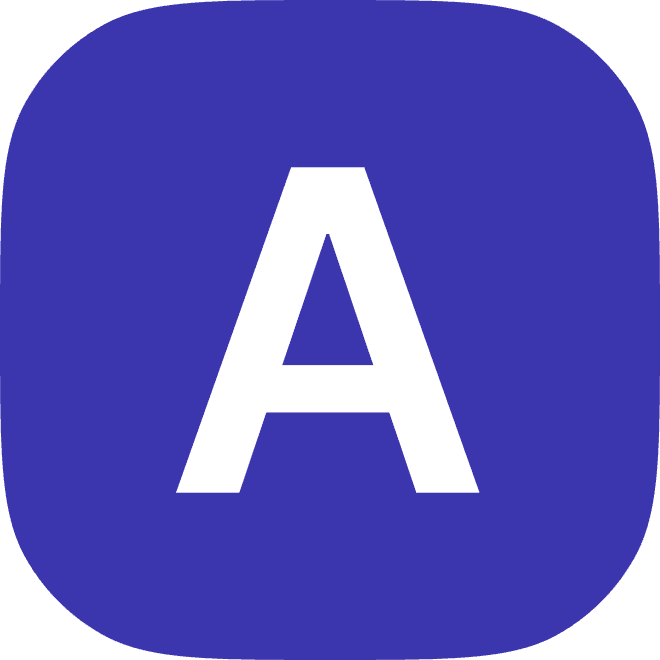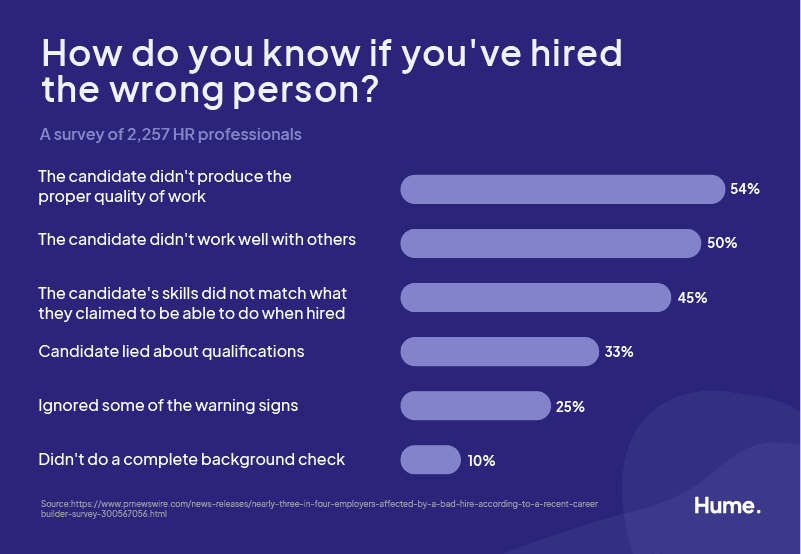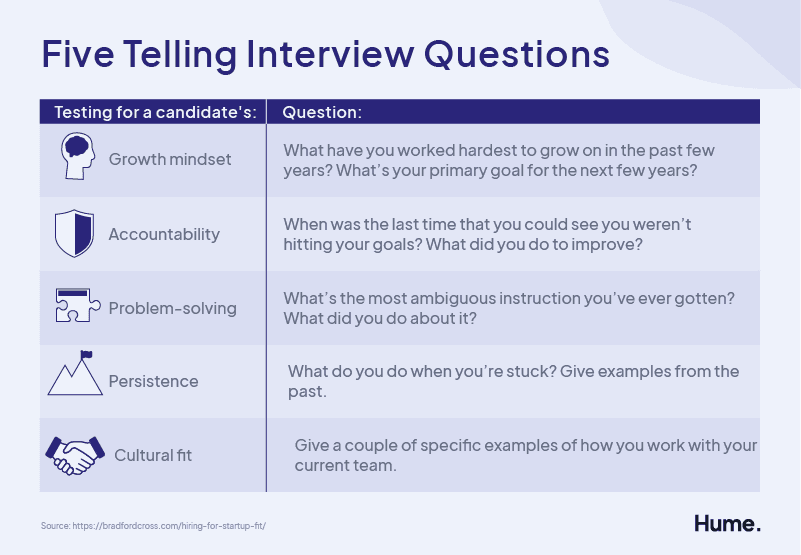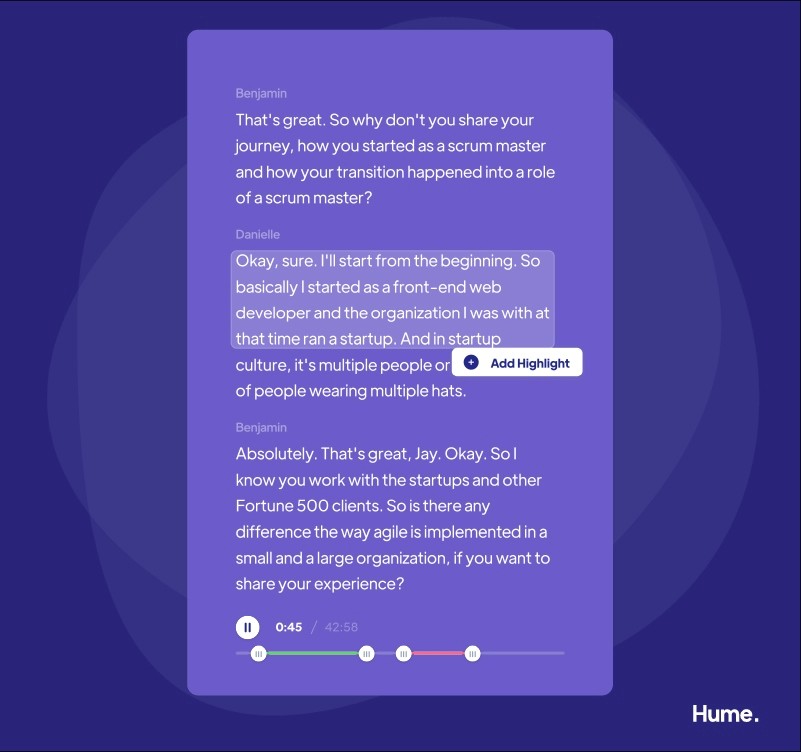How to Hire the Best Candidate (Not Just the Best Interviewer)

2023
Interviews can feel like a greatest hits compilation of a candidate's work experiences. A highlight reel of all their professional success. A glossy Instagram filter atop a LinkedIn CV.
That's not to discount their importance in the hiring process. When done right — checked for bias and supplemented with other assessments — they're the perfect way to get to know more about a potential employee.
But smooth interviewers will magnify their good qualities, and sometimes even distort them (90% of college seniors embellish their credentials in job interviews to make better impressions). So how do you get an honest glimpse of whether or not you’re actually hiring top talent who will get the job done?
And what about the flip side? Does a timid, awkward interview translate to bad on-the-job performance?
No! As it turns out, unstructured interviews can be no better performance predictors than a coin toss. Such uncertainty leads to bad hires (something three quarters of the workforce is affected by), which can prove costly, draining, and bad for company morale.

So how do you sift through the noise of an interview and hire the right person? We'll give you all the tips here.
Know what you're looking for
To hire the best candidate, you need a good sense of what on-the-job success will look like.
It all starts with the job description, where it's helpful to spell out desired performance objectives (the more the merrier) instead of selecting for personality traits.
Behavioral traits, on the other hand, can be a helpful compass. Beyond the job description, ask questions about who you want. Are you looking for enterprising employees who take creative risks, or would you prefer someone more cautious? Is ambition a virtue, or is your ideal hire more focused on their main responsibilities, less focused on ladder-climbing?
If you can identify five core traits and map out five concrete tasks you want someone to accomplish in their first year, then you can sketch the contours of your ideal candidate.
Keep in mind: the "ideal candidate" isn't always a real person within your hiring pool. The term can be a helpful measuring stick. But being too married to finding the absolute perfect match exacerbates a type of interview bias called central tendency. It can also blind you from applicants with unconventional qualifications who may make for great candidates.
If you're ever in doubt of what qualities you're looking for, ask a colleague who'd be working with that employee for advice.
Assign a trial project
A crucial reason why interviews alone don't predict job performance: you're hanging out with a candidate instead of seeing what it's like to actually work with them.
But you can always test their chops with a homework assignment.
Think of it as a job audition, which supplements the interview by giving a real sense of how candidates work, think, and communicate — in addition to assessing whether they're cut out for the demands of the role. If their task is written and turned in, you can easily compare it with other submissions across your hiring pool.
It always helps to assign a task relevant to the job — like asking a prospective salesperson to deliver a pitch, or getting a web developer applicant to design a landing page. You can even outsource a real, current problem your company is grappling with for a fresh perspective — and potentially a new solution.
Since this is real work, it's best to pay the candidate for their time if you can, the same way you would a contractor.
Ask the right questions
Some run-of-the-mill interview questions are worth asking (candidates should always have a ready answer for why they want to work with you). But most will be prepared to answer questions they've been asked a million times before, skillfully dodging any signs of weakness.
But you don't want canned responses. You want predictors of behavior. That's why it's always helpful to encourage interviewees to tell you about past work problems — running down how they handled them and what the outcome was.
These types of questions have a well-trodden formula, complete with an opening (we rely on self-directed work), the problem (tell me about a time when you set a goal for yourself), and the behavior (and how you used strategic planning to accomplish it).
You can also throw in curveball questions — ones you've designed yourself — into the mix. It used to be en vogue for tech companies to ask gotcha riddles like "a man pushed his car into a hotel and lost his fortune. What happened?" But those types of brain teasers are useless in a job interview.
Better curveball questions give you a better sense of who the candidate is and what they're passionate about, things like what is your natural strength?

Regardless of what you ask, remember that it's always good practice to pose the same line of questions to every candidate you interview, to reduce interview bias.
Introduce candidates to colleagues
We all have our blindspots. Even the most seasoned interviewers are bound to misjudge certain answers, skills, and experiences.
That's why it always helps for recruiters to get a second opinion. Then a third. And then as many more as they can muster.
If you get colleagues involved in the interview process, you gain input from people who'd be working with the candidate every day, and are therefore good judges of whether a candidate is properly qualified. These colleagues can often spot strengths and weaknesses a conventional interviewer overlooks.
These coworkers don't have to always re-tread an entire 45 minute interview. If the candidate is in the office, consider having someone give them a brief tour. Then organize a coffee meet-and-greet with a department head.
For virtual interviews, you can always include five-minute chats with colleagues before or after the main, longer discussion. And with the right tool, you can even share snippets of interview highlights with coworkers to get their take.
Once enough people meet the candidate, follow-up with all participating colleagues to see if there's any sort of consensus forming.
Check references — and beyond
Interviewees can tell you the story of what they did in their past job. But there's no real way to verify it without a tried-and-true reference check.
You should ask candidates to list references, and call at least a couple of them to get their take on past performance.
But keep in mind that potential hires will likely only refer you to colleagues who will praise them.
If you want a more objective view, do your own sleuthing. Browse LinkedIn (and other social media) to find out who a candidate used to work with, and reach out for their opinions. They may not always get back to you, and out of respect for their time, you want to keep this brief. But if you take this step, you'll likely get a more honest view of a candidate's strengths and weaknesses — one that isn't overly promotional.
Assess cultural fit
Your platonic ideal of the best job candidate may involve sterling academic credentials and years of relevant work experience. But what's often overlooked is just as important: how a potential hire fits within your team ecosystem.
If a new employee is aligned with company culture, they can get the hang of a job quicker while enjoying it more. Ask yourself: how will this candidate interact with their team members? How well do they understand your customers?
The better an interview is at gauging a candidate's cultural fit, the likelier a company is to make the right hire.
Emphasize diversity
Homogeneous workplaces are still too common. Not only are they an unfair reflection of the available workforce. They're also a huge drain on innovation, problem-solving, and creativity. Diversity even correlates with better financial performance — up to 35% above industry means. Why? You need a range of perspectives to land on the right solutions.
If you want a diverse hiring pool, you should market your job opening broadly, reaching out to organizations that help recruit people from underrepresented communities.
Reduce bias
One of the biggest hurdles of cultivating a diverse workplace is bias. Even if you strive to temper any hasty or overt stereotyping, the hiring process is fraught with unconscious bias, causing hirers to make snap judgments of candidates without even knowing.
This stifles fairness. And a fair interview process is the only way to find the best hire. So make sure you're reducing bias whenever you can — whether that means scoring candidates on a rubric, standardizing interview questions, interrogating your first impression, asking for anonymous test submissions, or conducting panel interviews, or something else.
Turn the tables and let the candidate interview you
Interviews are a two-way street. While you're judging whether a candidate's a good fit for your role, job seekers are making their own judgments about company culture, gauging whether they envision success and fulfillment.
That's why at the end of interviews, you should set aside time for candidates to ask their own. It's helpful for the candidate, but also helps you figure out if they're excited about the position, along with how well they understand the company.
A product designer named Lily Konings recently posted a Twitter thread of questions candidates should ask hiring managers, all of which you should be prepared to answer honestly:
When was the last time you promoted someone on your team? How did it happen?
Why did the last person in this role leave?
How do you nurture psychological safety in your team?
When was the last time you supported a direct report's growth, even if it meant leaving your team or company?
Collect and standardize interview data
If you don't have good notes to back up an interview, all you have left is your memory of it — which can be fuzzy and prone to bias.
To hire the best person, you need data — information behind each candidate you can easily share across your team and objectively compare against others in your hiring pool.
Now, you could type or write these notes out. But that distracts from the interview — if your head is down the whole time trying to document everything, you're distracting the interviewer and making for a sub-par experience.
So how do you run a stellar interview while collecting data that'll lead to hiring the best candidate? Try Hume, an AI-powered interview companion that records, transcribes, and annotates conversations to bring evidence, equity, and objectivity into the hiring process.

Hume uses speech recognition technology to provide transcripts of entire interview exchanges, and allows you to highlight the most important moments to share with your hiring panel. You can easily discern how different candidates answered the same kinds of questions, guaranteeing everyone gets a fair shake. The platform also provides metrics like time spent talking vs. listening, questions asked vs. questions answered, and more.
This helps companies discern whether interviewees are a good fit for the role while ensuring interviewers are following a consistent line of questioning. If you want to coach hiring managers on how to conduct a best-in-class interview, you can even use Hume's playlists feature to create your own coaching platform, complete with instructions on how to sell the role, look for cultural fit, and judge interview answers.
Great interviewers can make for lousy hires, and vice versa. If you want the best of both worlds — a seamless interview experience that empowers the best hiring decision — visit Hume's website to sign up for early access. You can also follow our LinkedIn page to learn more about hiring the right people.



